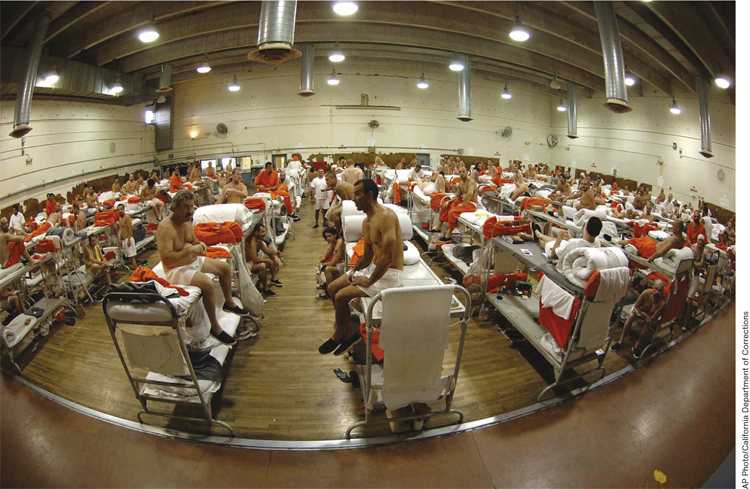5.3 Drugs and Consciousness: Artificial Inspiration
The author of the dystopian novel Brave New World, Aldous Huxley (1932), once wrote of his experiences with the drug mescaline. The Doors of Perception described “a world where everything shone with the Inner Light, and was infinite in its significance. The legs, for example, of a chair—
Being the legs of a chair? This probably is better than being the seat of a chair, but it still sounds like an odd experience. Still, many people seek out such experiences, often through drug use. Psychoactive drugs are chemicals that influence consciousness or behavior by altering the brain’s chemical message system. You read about several such drugs in the Neuroscience and Behavior chapter when we explored the brain’s system of neurotransmitters. And you will read about them in a different light when we turn to their role in the treatment of psychological disorders in the Treatment chapter. Whether these drugs are used for entertainment, for treatment, or for other reasons, they each exert their influence by increasing the activity of a neurotransmitter (the agonists) or decreasing its activity (the antagonists). Like Huxley experiencing himself becoming the legs of a chair, people using drugs can have experiences unlike any they might find in normal waking consciousness or even in dreams. To understand these altered states, let’s explore how people use and abuse drugs, and examine the major categories of psychoactive drugs.
psychoactive drugs
Chemicals that influence consciousness or behavior by altering the brain’s chemical message system.
156
Drug Use and Abuse

Why do children sometimes spin around until they get dizzy and fall down? There is something strangely attractive about altered states of consciousness, and people throughout history have sought out such states by dancing, fasting, chanting, meditating, and ingesting a bizarre assortment of chemicals to intoxicate themselves (Tart, 1969). People pursue altered consciousness even when there are costs—
In one study, researchers allowed rats to administer cocaine to themselves intravenously by pressing a lever (Bozarth & Wise, 1985). Over the course of the 30-
People usually do not become addicted to a psychoactive drug the first time they use it. They may experiment a few times, then try again, and eventually find that their tendency to use the drug increases over time due to several factors, including drug tolerance, the tendency for larger drug doses to be required over time to achieve the same effect. Physicians who prescribe morphine to control pain in their patients are faced with tolerance problems because steadily greater amounts of the drug may be needed to dampen the same pain. With increased tolerance comes the danger of drug overdose; recreational users find they need to use more and more of a drug to produce the same high. But then, if a new batch of heroin or cocaine is more concentrated than usual, the “normal” amount the user takes to achieve the same high can be fatal.
drug tolerance
The tendency for larger doses of a drug to be required over time to achieve the same effect.
What problems can arise in drug withdrawal?
Self-
157
Can addictions be overcome?
The psychological and social problems stemming from drug addiction are major. For many people, drug addiction becomes a way of life, and for some, it is a cause of death. But some people do overcome addictions. In one study, 64% of a sample of people who had a history of cigarette smoking had quit successfully, although many had to try again and again to achieve their success (Schachter, 1982). Indeed, large-

It may not be accurate to view all recreational drug use under the umbrella of “addiction.” Many people in the United States, for example, would not call the repeated use of caffeine an addiction, and some do not label the use of alcohol, tobacco, or marijuana in this way. In other times and places, however, the use of each of these drugs has been considered a terrifying addiction worthy of prohibition and public censure. In the early 17th century, for example, tobacco use was punishable by death in Germany, by castration in Russia, and by decapitation in China (Corti, 1931). Not a good time to be a smoker. By contrast, cocaine, heroin, marijuana, and amphetamines have each been popular and even recommended as medicines at several points throughout history (Inciardi, 2001). Societies react differently at different times, with some uses of drugs ignored, other uses encouraged, others simply taxed, and yet others subjected to intense prohibition (see the Real World box on p. 163). Rather than viewing all drug use as a problem, it is important to consider the costs and benefits of such use and to establish ways to help people choose behaviors that are informed by this knowledge (Parrott et al., 2005).
Types of Psychoactive Drugs
Four in five North Americans use caffeine in some form every day, but not all psychoactive drugs are this familiar. To learn how both the well-
|
|
Dangers |
||
|---|---|---|---|
|
Drug |
Overdose (Can taking too much cause death or injury?) |
Physical Dependence (Will stopping use make you sick?) |
Psychological Dependence (Will you crave it when you stop using it?) |
|
Depressants |
|
|
|
|
Alcohol |
X |
X |
X |
|
Benzodiazepines/Barbiturates |
X |
X |
X |
|
Toxic Inhalants |
X |
X |
X |
|
Stimulants |
|
|
|
|
Amphetamines |
X |
X |
X |
|
MDMA (Ecstasy) |
X |
|
? |
|
Nicotine |
X |
X |
X |
|
Cocaine |
X |
X |
X |
|
Narcotics (opium, heroin, morphine, methadone, codeine) |
X |
X |
X |
|
Hallucinogens (LSD, mescaline, psilocybin, PCP, ketamine) |
X |
|
? |
|
Marijuana |
|
? |
? |
Depressants
Depressants are substances that reduce the activity of the central nervous system. Depressants have a sedative or calming effect, tend to induce sleep in high doses, and can produce both physical and psychological dependence.
depressants
Substances that reduce the activity of the central nervous system.
The most commonly used depressant is alcohol, the “king of the depressants,” with its worldwide use beginning in prehistory, its easy availability in most cultures, and its widespread acceptance as a socially approved substance. Fifty-
Alcohol’s initial effects, euphoria and reduced anxiety, feel pretty positive. As it is consumed in greater quantities, drunkenness results, bringing slowed reactions, slurred speech, poor judgment, and other reductions in the effectiveness of thought and action. The exact way in which alcohol influences neural mechanisms is still not understood, but like other depressants, alcohol increases activity of the neurotransmitter GABA (De Witte, 1996). As you read in the Neuroscience and Behavior chapter, GABA normally inhibits the transmission of neural impulses, and so one effect of alcohol is to stop the firing of other neurons. But there are many contradictions. Some people using alcohol become loud and aggressive, others become emotional and weepy, others become sullen, and still others turn giddy—
158
Expectancy theory suggests that alcohol effects can be produced by people’s expectations of how alcohol will influence them in particular situations (Marlatt & Rohsenow, 1980). So, for instance, if you’ve watched friends or family drink at weddings and notice that this often produces hilarity and gregariousness, you could well experience these effects yourself should you drink alcohol on a similarly festive occasion. Seeing people getting drunk and fighting in bars, in turn, might lead to aggression after drinking. Evidence for the expectancy theory has been obtained in studies where participants are given drinks containing alcohol or a substitute liquid. Some people in each group are led to believe they had alcohol, and others are led to believe they did not. These experiments often show that the belief that one has had alcohol can influence behavior as strongly as the ingestion of alcohol itself (Goldman, Brown, & Christiansen, 1987). You may have seen people at parties getting rowdy after only one beer—
expectancy theory
The idea that alcohol effects can be produced by people’s expectations of how alcohol will influence them in particular situations.
Why do people experience being drunk differently?
Another approach to the varied effects of alcohol is the theory of alcohol myopia, which proposes that alcohol hampers attention, leading people to respond in simple ways to complex situations (Steele & Josephs, 1990). This theory recognizes that life is filled with complicated pushes and pulls, and our behavior is often a balancing act. Imagine that you are really attracted to someone who is dating your friend. Do you make your feelings known or focus on your friendship? The myopia theory holds that when you drink alcohol, your fine judgment is impaired. It becomes hard to appreciate the subtlety of these different options, and the inappropriate response is to veer full tilt one way or the other. So, alcohol might lead you to make a wild pass at your friend’s date or perhaps just cry in your beer over your timidity—
alcohol myopia
A condition that results when alcohol hampers attention, leading people to respond in simple ways to complex situations.
159
Both the expectancy and myopia theories suggest that people using alcohol will often go to extremes (Cooper, 2006). In fact, it seems that drinking is a major contributing factor to social problems that result from extreme behavior. Drinking while driving is a main cause of auto accidents. Approximately one-

Compared to alcohol, the other depressants are much less popular but still are widely used and abused. Barbiturates such as Seconal or Nembutal are prescribed as sleep aids and as anesthetics before surgery. Benzodiazepines such as Valium (diazepam) and Xanax are also called minor tranquilizers and are prescribed to treat anxiety or sleep problems. Physical dependence is possible because withdrawal from long-
Stimulants
Stimulants are substances that excite the central nervous system, heightening arousal and activity levels. They include caffeine, amphetamines, nicotine, and cocaine, and Ecstasy; and they sometimes have a legitimate pharmaceutical purpose. For example, amphetamines (also called speed) were originally prepared for medicinal uses and as diet drugs; however, some are widely abused, causing insomnia, aggression, and paranoia with long-
stimulants
Substances that excite the central nervous system, heightening arousal and activity levels.
Do stimulants create dependence?
Ecstasy (also known as MDMA, “X,” or “E”) is an amphetamine derivative. Ecstasy is particularly known for making users feel empathic and close to those around them, but it has unpleasant side effects such as interfering with the regulation of body temperature, making users remain highly susceptible to heatstroke and exhaustion. Although Ecstasy is not as likely as some other drugs to cause physical or psychological dependence, it nonetheless can lead to some dependence. What’s more, the impurities sometimes found in street pills are also dangerous (Parrott, 2001). Ecstasy’s potentially toxic effect on serotonin neurons in the human brain is under debate, although mounting evidence from animal and human studies suggests that sustained use is associated with damage to serotonergic neurons and potentially associated problems with mood, attention and memory, and impulse control (Cox et al., 2014; Urban et al., 2012).
160
Cocaine is derived from leaves of the coca plant, which has been cultivated by indigenous peoples of the Andes for millennia and chewed as a medication. Yes, the urban legend is true: Coca-
What are some of the dangerous side effects of cocaine use?
Nicotine is something of a puzzle. This is a drug with almost nothing to recommend it to the newcomer. It usually involves inhaling smoke that doesn’t smell that great, and there’s not much in the way of a high either—

Narcotics
Opium, which comes from poppy seeds, and its derivatives heroin, morphine, methadone, and codeine (as well as prescription drugs such as Demerol and Oxycontin), are known as narcotics (or opiates), highly addictive drugs derived from opium that relieve pain. Narcotics induce a feeling of well-
narcotics (or opiates)
Highly addictive drugs derived from opium that relieve pain.

Why are narcotics especially alluring?
The brain produces endogenous opioids or endorphins, which are neurotransmitters closely related to opiates. As you learned in the Neuroscience & Behavior chapter, endorphins play a role in how the brain copes internally with pain and stress. These substances reduce the experience of pain naturally. When you exercise for a while and start to feel your muscles burning, for example, you may also find that there comes a time when the pain eases—
161
Hallucinogens
The drugs that produce the most extreme alterations of consciousness are the hallucinogens, drugs that alter sensation and perception and that often cause visual and auditory hallucinations. These include LSD (lysergic acid diethylamide, or acid), mescaline, psilocybin, PCP (phencyclidine), and ketamine (an animal anesthetic). Some of these drugs are derived from plants (mescaline from peyote cactus, psilocybin or “shrooms” from mushrooms) and have been used by people since ancient times. For example, the ingestion of peyote plays a prominent role in some Native American religious practices. The other hallucinogens are largely synthetic.
hallucinogens
Drugs that alter sensation and perception and often cause visual and auditory hallucinations.
What are the effects of hallucinogens?
These drugs produce profound changes in perception. Sensations may seem unusually intense, stationary objects may seem to move or change, patterns or colors may appear, and these perceptions may be accompanied by exaggerated emotions ranging from blissful transcendence to abject terror. These are the “I’ve-

Marijuana
Marijuana (or cannabis) is a plant whose leaves and buds contain a psychoactive drug called tetrahydrocannabinol (THC). When smoked or eaten, either as is or in concentrated form as hashish, this drug produces an intoxication that is mildly hallucinogenic. Users describe the experience as euphoric, with heightened senses of sight and sound and the perception of a rush of ideas. Marijuana affects judgment and short-
marijuana (or cannibis)
The leaves and buds of the hemp plant, which contain a psychoactive drug called tetrahydrocannabinol (THC).
What are the risks of marijuana use?
The addiction potential of marijuana is not strong, as tolerance does not seem to develop, and physical withdrawal symptoms are minimal. Psychological dependence is possible, however, and some people do become chronic users. Marijuana use has been widespread around the world throughout recorded history, both as a medicine for pain and/or nausea and as a recreational drug, but its use remains controversial. Marijuana abuse and dependence have been linked with increased risk of depression, anxiety, and other forms of psychopathology. Many people also are concerned that marijuana (along with alcohol and tobacco) is a gateway drug, a drug whose use increases the risk of the subsequent use of more harmful drugs. The gateway theory has gained mixed support, with recent studies challenging this theory and suggesting that early-
gateway drug
A drug whose use increases the risk of the subsequent use of more harmful drugs.
162
SUMMARY QUIZ [5.3]
Question 5.8
| 1. | Psychoactive drugs influence consciousness by altering the effects of |
- agonists.
- neurotransmitters.
- amphetamines.
- spinal neurons.
b.
Question 5.9
| 2. | Tolerance for drugs involves |
- larger doses being required over time to achieve the same effect.
- openness to new experiences.
- the initial attraction of drug use.
- the lessening of the painful symptoms that accompany withdrawal.
a.
Question 5.10
| 3. | Drugs that heighten arousal and activity levels by affecting the central nervous system are |
- depressants.
- stimulants.
- narcotics.
- hallucinogens.
b.
Question 5.11
| 4. | Alcohol expectancy refers to |
- alcohol’s initial effects of euphoria and reduced anxiety.
- the widespread acceptance of alcohol as a socially approved substance.
- alcohol leading people to respond in simple ways to complex situations.
- people’s beliefs about how alcohol will influence them in particular situations.
d.
163
The Real World: Drugs and the Regulation of Consciousness
Drugs and the Regulation of Consciousness
Everyone has an opinion about drug use. Is consciousness something that governments should be able to legislate? Or should people be free to choose their own conscious states (McWilliams, 1993)?

Individuals and governments alike answer these questions by pointing to the costs of drug addiction, both to the addict and to the society that must “carry” unproductive people, pay for their welfare, and often even take care of their children. Drug users appear to be troublemakers and criminals, the culprits behind all those drug-

Drug use did not stop, though, and instead, prisons filled with people arrested for drug use. From 1990 to 2007, the number of drug offenders in state and federal prisons increased from 179,070 to 348,736—
What can be done? The policy of the Obama administration is to wind down the war mentality and instead focus on reducing the harm that drugs cause (Fields, 2009). This harm reduction approach focuses on reducing the harm that high-
There appears to be increasing support for the idea that people should be free to decide whether they want to use substances to alter their consciousness, especially when use of the substance carries a medical benefit, such as decreased nausea, decreased insomnia, and increased appetite. Since 1996, 21 states and the District of Columbia have enacted laws to legalize the use of marijuana for medical purposes. On November 6, 2012, Colorado and Washington became the first two states to legalize marijuana for purely recreational purposes. The fact that marijuana is still illegal under federal law complicates matters, and it may take years before the legal issues are fully resolved. Indeed, upon learning of the passing of the legalization initiative, Colorado governor John Hickenlooper warned citizens of Colorado: “Federal law still says marijuana is an illegal drug so don’t break out the Cheetos or Goldfish too quickly” (Weiner, 2012).
164